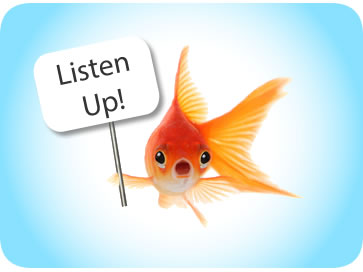
Our inboxes are consistently overflowing with information. We know yours are too. Everyone is trumpeting from the rooftops about the good works they are doing - and rightfully so. However many organizations, even after all that fanfare and flag waving, are hearing nothing but crickets.
We know you’re eager to communicate with the people who make all that fanfare possible. And we also know these communications are integral to the function and long term success of your program. So then, what’s the problem?
The problem is that we, collectively, just don’t have the time to listen anymore. The Associated Press states that the average attention span in 2012 was about 8 seconds, down from 12 seconds in 2000. To compare- the average attention span of a goldfish is 9 seconds.
In the midst of all the tweets and texts comprising this digital era, it is more important than ever for the non-profit to stay current with the communication pacing demands. Translation? Same ideas but less words… unless you’re emailing a goldfish, of course.
8 tips for concise communications:
- Begin with a content strategy. Your communications should be cohesive and easy to follow. Kivi Leroux Miller, non-profit marketing strategist, suggests instead of publishing a random collection of articles and pieces of content, each piece you create should fit into the larger story. Organization is key to successful content flow. Pick up a book on corporate content strategy. You’ll be amazed at how a simple re-arrange of your information can change the entire feel of your message, not to mention its effectiveness.
- Time your communication release dates carefully. Dan Zarrella, a social media researcher and author, finds some surprising results relating to the timing of corporate communications. “If asked what day would be best for marketing email, most of us would pick a weekday. Surprise! Turns out that the highest click through rates are... Saturday and Sunday. Who knew? Most unsubs (people unsubscrbing from your emails) happen on Monday and Tuesday.” Here’s hoping you’re reading this during your Saturday morning cup of coffee!
- Trim the fat. Head back to English 101. Eliminating wordy phrases and modifiers will help you sound more concise and will get your message across faster. Also, try trading nouns for verbs in your statements. For example- instead of- “We are sending you this email in the hope that you will be inspired to action.”, try- “We are emailing in hopes of inspiring action.”. Much more efficient, don’t you think?
- Examine your format. This should be a no brainer, but we often become so bogged down by the intent behind our message that we forget to simply stand back and look at it. Short paragraphs or bullet points are far easier to skim than long, anecdotal paragraphs. And let’s face it; your readers want to skim. Help them out.
- Utilize graphics. Informational images can free up text and drive ideas home quicker. Get your numbers out there in the form of a chart or table. Tug at your reader’s subconscious with a memorable photo or image. The right graphic placed correctly can create the same long-lasting feelings we need to emote without the muddiness of too much text.
- Use numbers to drive your point home. Numbers are concise, quick, and rule the non-profit world. Your benefactors, donors, volunteers, and organizers want to see the benefit of what you do. There’s no better way to demonstrate this than with a good, easy to read bottom line.
- Use stories or anecdotes, but make them brief. We realize the stories are the heart of your organization, and the heart should never be left out of non-profit communication. After all, those impactful, goose-bump inducing stories are what keep us in this field. You need to tell those stories. You just need to tell them quickly. Tom Ahern, educator in non-profit communication, stresses the importance of telling a good story, quickly. The speed and flow of your anecdotes really make or break the success of your message.
- Call for action. Rather than droning on for paragraphs about the cause and effect of your program, simply call your recipients to action. Amidst the profundity of our cause, it can be easy to forget that sometimes all people really need is a quick nudge. So tell your readers what you need from them. And get to the point quickly.
